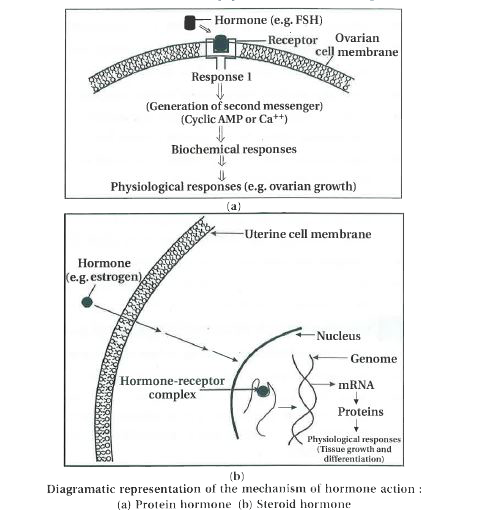Chemically hormones are divided into which groups ? Solution in Gujrati

Hormones preduce their effects on target tissues by binding to specific proteins called hormone receptors located in the target tissues only.
Hormone receptors present on the cell membrane of the target cells are celled membrane bound receptors and the receptors present inside the target cell are called intracellular receptors, mostly nuclear receptors. Binding of a hormone to its receptor leads to the formation of a hormone receptor complex.
Each receptor is specific to one hormone only and hence receptors are specific.
Hormone receptor complex formation leads to certain biochemical changes in the target tissue.
Target tissue metabolism and hence physiological functions are regulated by hormones.
On the basis of their chemical nature, hormones can be divided into :
(i) Peptide, polypeptide, protein hormones (e.g., insulin, glucagon, pituitary hormones, hypothalamic hormones, etc.)
(ii) Steroids (e.g., cortisol, testosterone, estradiol and progesterone)
(iii) Iodothyronines (thyroid hormones)
(iv) Amino - acid derivatives (e.g., epinephrine).
Hormones which interact with membrane - bound receptors normally do not enter the target cell, but generate second messengers (e.g., cyclic AMP,IP3Ca++ etc.) which in turn regulate cellular metabolism.
Hormones which interact with intracellular receptors (steroid, iodothyronines, etc.) mostly regulate gene expression or chromosome function by the interaction of hormone - receptor complex with the genome.
Cumulative biochemical actions result in physiological and developmental effects.
Topper's Solved these Questions
- BOOK - KUMAR PRAKASHANCHAPTER - CHEMICAL COORDINATION AND INTEGRATION EXERCISE - Section-B (Differentiate/Scientific Reason)9videos
CHEMICAL COORDINATION AND INTEGRATION
- BOOK - KUMAR PRAKASHANCHAPTER - CHEMICAL COORDINATION AND INTEGRATION EXERCISE - Section-C (Definition/Explanation-Terms/Location-Function/Differentive word)17videos
CHEMICAL COORDINATION AND INTEGRATION
- BOOK - KUMAR PRAKASHANCHAPTER - CELL CYCLE AND CELL DIVISION EXERCISE - Question Paper (Describe in detail )1videos
CELL CYCLE AND CELL DIVISION
- BOOK - KUMAR PRAKASHANCHAPTER - DIGESTION AND ABSORPTIONEXERCISE - Question from Module (Question Paper)11videos
DIGESTION AND ABSORPTION
Similar Questions
Neural system and Endocrine system
01:09View SolutionDefinitions / Explanation : Hormone
01:47View SolutionDescribe various subphases of prophase - I of Meiosis - I.
03:15View SolutionWhy are villi present in the intestine and not in the stomach ?
View SolutionWhich of the following hormones is not chemically glycoprotein
01:40View SolutionName two groups in which the phenomenon of catalysis can be divided. Give one example of each group with chemical equation.
04:34View SolutionWhat are hormones ? Classify hormones regarding their chemical nature. Cite at least one example of each group.
01:47View SolutionChemically hormones are :-
06:57View Solutionएन्जाइम किस समूह के रसायन हैं ?
View SolutionName the two groups into which phenomenon of catalysis can be divided. Give an example of each group with the chemical equation involved.
03:02View Solutionरासायनिक दृष्टि से हार्मोन अधिकतर किस प्रकृति के होते हैं?
06:01View SolutionName the two groups into which phenomenon of catalysis can be divided. Give an example of each groups with the chemical equation involved.
02:05View SolutionName the two groups into which the phenomenon of catalysis can be divided. Give an example of each group with the chemical equation involved.
03:23View Solutionमादा लिंग हॉर्मोन को कहते हैं
अथवा
निम्न में से कौनसा हॉर्मोन रसायनिक रूप से ग्लायकोप्रोटीन नहीं है03:10View Solutionनिम्न में से कौन सा समूह प्राकृतिक हॉर्मोन्स का है?
06:35View Solution

